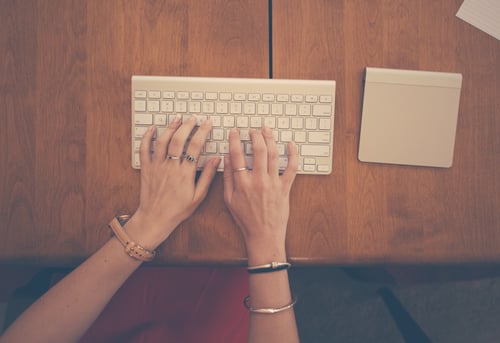Measuring how people are interacting with your content marketing is as important as creating it in the first place. That’s because by measuring what’s working and what isn’t, you’ll be able to identify issues and opportunities, both of which will help you improve your B2B content marketing strategy and achieve results.
The fantastic thing about digital content is that you can measure how it’s consumed and shared – and how your audience is engaging with it.
Here are eight of the most important metrics you should be tracking:
1. Number of visits
How many people have visited a particular page? This is probably the most fundamental type of B2B content marketing strategy metric there is. And it’s easy enough to determine when using the right software.
You can usually measure both the total number of visits and total number of unique visits. The latter tells you how many people visited (total visits may be higher as the same people may have visited more than once). Not all visits are created equal. A visit to a landing page for a download or whitepaper, for example, may be more valuable in terms of lead generation, than a visit to a blog post. Number of visits is a crucial content metric. But don’t stop there!
You should also track the number of views that your blog receives. Views measure the number of times a particular page has been viewed. As in the case of visits, you’ll be able to see total number of views and unique views. Like visits, views are another measure of how many people have consumed your content. If you’re looking at individuals, the number of times they’ve viewed a particular page will give you a great idea on how interested they are in your different pages. This insight could help you craft further communications to these individuals and build out your B2B content strategy to appeal to the reader.

Similarly with emails, tracking opens and clicks will give you a good idea about what your audience is interested in, so that you can hone future communications and your sales team can follow up with people who are clicking on certain bits of content.
The key to increasing both visits and views is promotion. So make sure you have a solid strategy in place for this. It isn’t enough to just share socially, broaden the reach and encourage the whole team (or even company!) to share the post from as many social media accounts as possible. You can no use software that enables you to do this in half the time and takes away any hassle for your team members and allows you to do this on their behalf. Go further and engage with industry relevant websites that will host your blog as guest content, this helps you get found as well as building a consistent linking back to your websites from these guest blogs.
2. Conversion rates
People talk about ‘converting’ visitors into buyers. We recommend measuring how well your call to actions, your blog posts and your landing pages do this.
1. Call to action (CTA) buttons
It’s hard to predict what will work. The only way to know for sure is to run A/B tests. Did you know? 30% of all A/B tests are on CTA buttons! There’s lots of great advice out there on where to start. The trick is to always be testing, analysing and improving.
2. Landing pages
These are the entry point for your website. Again, the key to maximising their conversion rates is to constantly test many different variables. But you may only see small increases focusing on small details. Focus on the offer and build the page around this.
3. Blog posts
You can set up actions you want people to perform after reading your blog posts. This could be subscribing to your email or downloading another eBook, for example. It’s important to measure how many people are taking these actions so that you improve your performance. You can do that by tweaking your CTAs and keywords.
3. Comments
While people’s visits and views are the most basic activity you can measure, their comments are possibly even more meaningful. Leaving a comment takes a lot more effort than simply clicking a ‘like’ button, for example. As a result, comments are a strong indication of how engaged people are.
So embrace commenting. Enable comments on your blog (some moderation will be necessary as spammers may target you fairly quickly) and encourage sharing by incorporating social sharing buttons into your design (more of this later). Comments are a fantastic way of starting a conversation with your customers and developing your relationship.
You shouldn’t worry about negative comments. See them as an opportunity to solve someone’s problem for them. Not only will you be able to turnaround a complainer, you’ll also be helping anyone else who’s reading and has the same problem and demonstrating your commitment to customer service.
4. Mobile readership
How many of your visitors are consuming your content on mobile devices? It’s likely that around 50% of your audience will be viewing your content on the move in this way but you’ll be able to measure it exactly and tailor your content marketing to their needs.
Whatever the metric, you need to bear mobile users in mind. Does your content display well on mobiles? Should you consider infographics to make your content easier to consume? Have you made your copy as concise as possible? Is your website responsive? Does it change depending on the device on which it’s being viewed? If not, you’ll want to fix that. It can be tricky to navigate a website designed for desktop on a mobile device and this will drive visitors away.
5. Geography
Where is your audience? What country are they in? This insight is easily discoverable via the right software platform and will help you tailor your content strategy and allocate budget if required.

6. Click/heat maps
Visits and views let you see who’s looking at what pages, but how are people engaging and interacting with a particular piece of content? Click/heat maps provide a clue. Heat maps are graphical representations of data. They show how visitors behave while viewing content. Click maps show where people are clicking. They’re particularly useful in showing you how well your calls to action (CTAs) are doing. If you’re not getting a high click through rate on a particular button, you could try changing its text, colour or shape for next time.
You can also have maps that show you how people are scrolling or moving their mouse. For example, if you saw that people weren’t scrolling beyond a certain point, you could change your B2B content marketing strategy to attempt to fix that.
7. Social sharing
We mentioned social sharing at the beginning of this blog post, in the context of conversations. The point is to make it as easy as possible to share your content on social networks, such as Twitter, Facebook and LinkedIn, Google+ and even Instagram. All people have to do is click a button. You can even pre-populate the posts with copy, such as the piece’s title, and/or add your own comment, to engage the people in your network you think will find the content useful. Having a presence on Google+ will also help Google recognise you as a thought leader and will help boost your SEO rankings.
Not only will this sharing increase your content’s visits and views, you can also track these shares, giving you an idea of how many people your content reached.
8. Engagement
So-called ‘consumption’ metrics, such as visits or views, are all very well. But you can do better. Use software to measure average time on page, pages per session, new vs returning and how people are finding out about your content. Arm yourself with these engagement metrics, plus the other seven we’ve discussed above. You’ll have a much better idea about what your audience is interested in and how you can improve your efforts by helping them get it.
Download our free guide to inbound marketing today for information on content marketing...



.png?width=500&name=A%20group%20of%20people%20talking%2c%20taking%20part%20in%20market%20research.%20(3).png)






